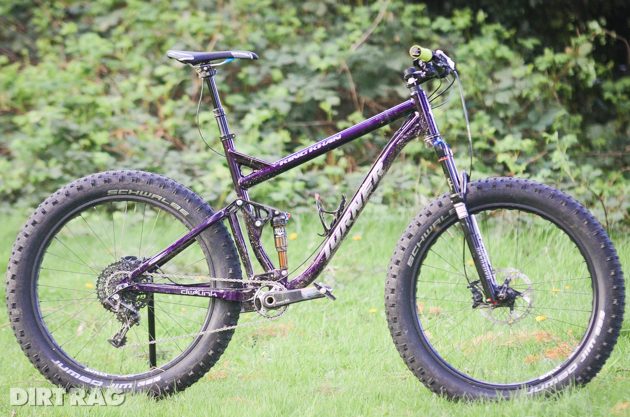First Impressions: Turner King Khan full-suspension fat bike
Originally posted on April 13, 2015 at 5:19 amI have to admit, when fat bikes first came around, I didn’t like them either. They looked cumbersome and slow. Not my idea of a good time. But once I started riding a few, I started to see the light. Are they a niche product that could only be someone’s “other” bike? Or are they a viable, year-round alternative to those “skinny” tire mountain bikes?

The folks at Turner clearly see the market moving towards the latter. The new King Khan is one of the first production full-suspension fat bikes and is at the cutting edge of where the bikes—and the customers—will go. With the same dw-link suspension and American-made aluminum construction, the King Khan strikes a familiar profile to fans of Turner’s bikes. The kinematics are adapted from the Sultan 29er model and shares the same 125 mm of travel, but it obvious to see that the frame had to make several accommodations for the massive tires. The suspension moves through a custom tuned Fox Float CTD shock, with the Kashima version available for an upcharge. The frame is paired with a RockShox Bluto fork moving through 120 mm of travel.

That said, the measurements are modest by fat bike standards. The rear end spacing is 177 mm with a thru axle, and the Schwalbe Jumbo Jim 26×4.0 tires are mounted to Surly Large Marge 65 mm rims. The Khan was designed to take advantage of the big tires without the even larger weight penalty of using the largest possible components. The King Khan is sold as a frame only ($2,695) or built with Turner’s fat bike kit ($5,999) featuring a SRAM 1×11 drivetrain, as there is no provision for a front derailleur.

As if it were possible to stay subtle on the trail, the King Khan is available in 10 different finish options, including raw with a clear coat. Designed for all-purpose trail riding, the King Khan has a 69.5 degree head tube angle, 73 degree seat tube angle, 13.3 inch bottom bracket height and 18.2 inch chainstays. The complete bike, as you see it here with pedals and the dropper post, tips the scales at 34.72 pounds. Not light by any means, but reasonable considering its size.

A note about the bike pictured here: It was originally set up for someone shorter than me, so when I raised the saddle and handlebars, it left the cables a little short. It still works fine, but should you purchase your own Turner don’t expect to see cables held on with zip-ties. All of Turner’s bikes use metal cable guide to keep them in place and looking fast.

On my first ride with the King Khan I set out to take it easy but still smashed all my Strava records at my favorite local trail network that largely consists of road climbs and singletrack descents. Riding with such massive wheels does take a bit getting used it. I liken it to the first time on a 29er, where things feel a bit odd until you get the hang of it. In this case not only does the additional diameter of the wheel roll over terrain well, the width means you don’t need to be as precise about your line choices. That said, you don’t always have a choice, as the weight of the wheels makes those small, nanosecond adjustments much more difficult than with a super light smaller wheel.

The King Khan certainly gets noticed, so I better be prepared to explain what it is to curious onlookers as I ride it through the summer for an upcoming full-length review in Dirt Rag. Want to make sure you don’t miss it? Order a subscription today.

Turner goes direct
The other big news from Turner this week is that the company has announced it will be offering its bikes direct to consumers. Riders will still be able to work with their local Turner dealer, but if they don’t have one nearby they can go straight to the source. You can configure your bike and buy it straight from the Turner website, along with extra parts, accessories or merchandise.